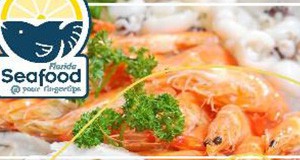
Marketing is an essential component of any business, including agriculture. Despite the important role of marketing, many smallholding operators/growers are reluctant to create a marketing plan. This 5-page fact sheet provides a rationale for developing a marketing plan, a step-by-step process for creating one, and a marketing plan worksheet. Written by Edward A. Evans and Fredy H. Ballen, and published by the UF Department of Food and Resource Economics, August 2015. (Photo credit: iStock/Thinkstock)
http://edis.ifas.ufl.edu/fe967
Tag: Food and Resource Economics Department
Summary of 2013/14 Production Costs for Indian River Fresh Market Grapefruit and Southwest Florida Juice Oranges
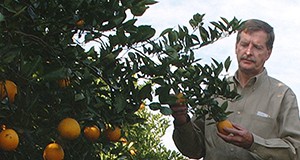
This 10-page report, developed through interviews with growers who managed their own citrus groves, outlines the cost of production budgets for fresh grapefruit and juice oranges grown during the 2013/14 season. The Florida citrus industry is on a steep learning curve as it collectively tries to maintain economically sustainable fruit yields from HLB-infected trees. Growers are experimenting with new materials and management strategies to reduce psyllid populations and improve a tree’s overall nutritional health. As a result, production costs have increased threefold since 2004. Between the 2012/13 and the 2013/14 seasons, production costs increased 30% and 34% for fresh grapefruit and juice oranges, respectively. Since 2004, production costs for fresh grapefruit have increased 182%, while costs to grow juice oranges have increased 211%.
Written by Fritz Roka, Ariel Singerman, and Ronald Muraro, and published by the UF Department of Food and Resource Economics, July 2015.
http://edis.ifas.ufl.edu/fe968
Seafood Knowledge, Perceptions, and Use Patterns in Florida: Findings from a 2013 Survey of Florida Residents
Over the past few years, consumers have begun to pay more attention to the nutritional benefits, sustainability, and environment impact of consuming seafood. However, media coverage of these concerns may leave consumers confused and uncertain about how they should incorporate seafood into their diets. In 2013, a survey was conducted to better understand Florida seafood consumer preferences, perceptions, and concerns. This 4-page fact sheet explains the survey’s findings and how they might help Extension deliver effective seafood-based education to Florida residents. Written by Lisa Krimsky, Charles Adams, and Bryan Fluech, and published by the UF Department of Food and Resource Economics, May 2015. http://edis.ifas.ufl.edu/fe965
Tree Assistance Program for Florida Citrus Greening
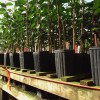 In September 2014, the USDA Farm Service Agency (FSA) announced additional support for commercial Florida citrus growers to manage greening, in the form of an expansion of the Tree Assistance Program (TAP). The original program assisted growers in the event the loss occurred within a single year due to a natural disaster such as a hurricane. The expanded TAP recognizes citrus greening (Huanglongbing, or HLB). The program provides growers cost-sharing financial assistance to replace trees that meet a mortality criterion within a time period of up to six years. This 4-page fact sheet describes eligibility requirements, how the program works, and how to calculate payments. Written by Ariel Singerman and Fritz Roka, and published by the UF Department of Food and Resource Economics, April 2015.
In September 2014, the USDA Farm Service Agency (FSA) announced additional support for commercial Florida citrus growers to manage greening, in the form of an expansion of the Tree Assistance Program (TAP). The original program assisted growers in the event the loss occurred within a single year due to a natural disaster such as a hurricane. The expanded TAP recognizes citrus greening (Huanglongbing, or HLB). The program provides growers cost-sharing financial assistance to replace trees that meet a mortality criterion within a time period of up to six years. This 4-page fact sheet describes eligibility requirements, how the program works, and how to calculate payments. Written by Ariel Singerman and Fritz Roka, and published by the UF Department of Food and Resource Economics, April 2015.
http://edis.ifas.ufl.edu/fe966
Floridian Consumer Perceptions of Local versus Organic Ornamental Plants
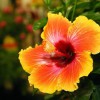 Horticultural consumers in Florida are interested in local and organically produced plants. But these terms can mean different things in different regions. UF/IFAS researchers conducted a survey last summer which suggests that consumers in central Florida define local as plants that are grown near where they are sold and identify the most important local benefits as product safety, quality, and community support. Organic plants are perceived as requiring fewer chemical additives and being healthier for the environment. The importance of these traits varies by plant type. This 5-page fact sheet was written by Hayk Khachatryan and Alicia Rihn, and published by the UF Department of Food and Resource Economics, February 2015.
Horticultural consumers in Florida are interested in local and organically produced plants. But these terms can mean different things in different regions. UF/IFAS researchers conducted a survey last summer which suggests that consumers in central Florida define local as plants that are grown near where they are sold and identify the most important local benefits as product safety, quality, and community support. Organic plants are perceived as requiring fewer chemical additives and being healthier for the environment. The importance of these traits varies by plant type. This 5-page fact sheet was written by Hayk Khachatryan and Alicia Rihn, and published by the UF Department of Food and Resource Economics, February 2015.
http://edis.ifas.ufl.edu/fe964
Economic Contributions and Ecosystem Services of Springs in the Lower Suwannee and Santa Fe River Basins of North-Central Florida
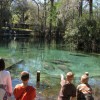 This study examined the economic contributions, consumer surplus, and ecosystem services provided by recreational use of fifteen major springs sites in north central Florida. The estimated annual economic contributions of springs-related recreational spending in north-central Florida for FY 2012/13 are summarized. Among the findings, there was $84.2 million in total visitor spending for springs recreation, and 1,160 full- and part-time jobs. This 4-page fact sheet was written by Tatiana Borisova, Alan W. Hodges, and Thomas J. Stevens, and published by the UF Department of Food and Resource Economics, April 2015.
This study examined the economic contributions, consumer surplus, and ecosystem services provided by recreational use of fifteen major springs sites in north central Florida. The estimated annual economic contributions of springs-related recreational spending in north-central Florida for FY 2012/13 are summarized. Among the findings, there was $84.2 million in total visitor spending for springs recreation, and 1,160 full- and part-time jobs. This 4-page fact sheet was written by Tatiana Borisova, Alan W. Hodges, and Thomas J. Stevens, and published by the UF Department of Food and Resource Economics, April 2015.
http://edis.ifas.ufl.edu/fe958
Economic Impacts of Highway Beautification in Florida
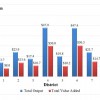 The Florida Department of Transportation is allocated money every year for highway landscaping projects. They make driving more pleasant and are better for the environment, but do they attract private investment and contribute to the economy? This study, commissioned by the FDOT, finds that the average annual economic impacts of highway beautification expenditures in Florida during 2008–2013 amounted to $46 million in output impacts and $28 million in value-added impacts. This 7-page fact sheet was written by Hayk Khachatryan, Alan W. Hodges, Mohammad Rahmani, and Thomas J. Stevens, and published by the UF Department of Food and Resource Economics, December 2014.
The Florida Department of Transportation is allocated money every year for highway landscaping projects. They make driving more pleasant and are better for the environment, but do they attract private investment and contribute to the economy? This study, commissioned by the FDOT, finds that the average annual economic impacts of highway beautification expenditures in Florida during 2008–2013 amounted to $46 million in output impacts and $28 million in value-added impacts. This 7-page fact sheet was written by Hayk Khachatryan, Alan W. Hodges, Mohammad Rahmani, and Thomas J. Stevens, and published by the UF Department of Food and Resource Economics, December 2014.
http://edis.ifas.ufl.edu/fe963
The Florida Natural Resources Leadership Institute
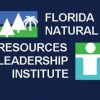 We are all dependent on Florida’s natural resources for jobs, health, and our quality of life. Decisions about the management and conservation of the State’s environment involve complex sets of issues and stakeholders. Expensive and time-consuming disputes often emerge over topics such as endangered species, land use, coastal and marine resources, and water quality and quantity. Effective leadership in managing such issues requires a specialized set of skills, tools, and strategies to build trust and promote innovation and collaboration among competing interests. To meet these needs, the Florida Natural Resources Leadership Institute (NRLI) was founded in 1998 to bring together professionals and stakeholders from diverse natural resource sectors to develop the skills required to engage the public and one another in collaborative decision-making. This 4-page fact sheet was written by Paul Monaghan, Emily Ott, Carol Lippincott, Ondine Wells, Jessica Ireland, Jon Dain, Bruce Delaney, and Roy Carriker, and published by the UF Department of Food and Resource Economics, December 2014.
We are all dependent on Florida’s natural resources for jobs, health, and our quality of life. Decisions about the management and conservation of the State’s environment involve complex sets of issues and stakeholders. Expensive and time-consuming disputes often emerge over topics such as endangered species, land use, coastal and marine resources, and water quality and quantity. Effective leadership in managing such issues requires a specialized set of skills, tools, and strategies to build trust and promote innovation and collaboration among competing interests. To meet these needs, the Florida Natural Resources Leadership Institute (NRLI) was founded in 1998 to bring together professionals and stakeholders from diverse natural resource sectors to develop the skills required to engage the public and one another in collaborative decision-making. This 4-page fact sheet was written by Paul Monaghan, Emily Ott, Carol Lippincott, Ondine Wells, Jessica Ireland, Jon Dain, Bruce Delaney, and Roy Carriker, and published by the UF Department of Food and Resource Economics, December 2014.
http://edis.ifas.ufl.edu/fe667
Handbook of Florida Fence and Property Law: Trees and Landowner Responsibility
 This 3-page fact sheet provides answers to these questions: What is the rule for the removal of a healthy tree on a boundary line? What is the liability for over-hanging branches and encroaching roots? and, Which landowner is responsible for dead or live trees falling on adjoining property? Written by Michael T. Olexa, Eugene E. Shuey, and Patrick H. Todd, and published by the UF Department of Food and Resource Economics, November 2014.
This 3-page fact sheet provides answers to these questions: What is the rule for the removal of a healthy tree on a boundary line? What is the liability for over-hanging branches and encroaching roots? and, Which landowner is responsible for dead or live trees falling on adjoining property? Written by Michael T. Olexa, Eugene E. Shuey, and Patrick H. Todd, and published by the UF Department of Food and Resource Economics, November 2014.
http://edis.ifas.ufl.edu/fe962
Economic Value of the Services Provided by Florida Springs and Other Water Bodies: A Summary of Existing Studies
 Florida residents and visitors place a high value on aquatic natural resources. This 8-page fact sheet reviews nine studies that demonstrate that Florida’s springs have a very large economic value, both for recreation and resource conservation. In these studies, economists measure the value of ecosystem services in dollar terms to assist management decisions concerning natural resources. Willingness to pay studies show that people who benefit from Florida springs place a high value on them. Economic contribution studies show that Florida springs play a significant role in local and state economic health and job creation. Written by Sara Wynn, Tatiana Borisova, and Alan Hodges, and published by the UF Department of Food and Resource Economics, November 2014. (UF/IFAS Photo by Tyler Jones.)
Florida residents and visitors place a high value on aquatic natural resources. This 8-page fact sheet reviews nine studies that demonstrate that Florida’s springs have a very large economic value, both for recreation and resource conservation. In these studies, economists measure the value of ecosystem services in dollar terms to assist management decisions concerning natural resources. Willingness to pay studies show that people who benefit from Florida springs place a high value on them. Economic contribution studies show that Florida springs play a significant role in local and state economic health and job creation. Written by Sara Wynn, Tatiana Borisova, and Alan Hodges, and published by the UF Department of Food and Resource Economics, November 2014. (UF/IFAS Photo by Tyler Jones.)
http://edis.ifas.ufl.edu/fe959
Estimating Willingness to Pay for New Mandarin Cultivars: A Revealed Preference Approach
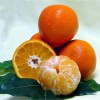 California has overtaken Florida to become the major US domestic mandarin producer. Despite a shift in consumer preferences toward the ‘Clementine’ mandarin that is widely grown in California, this cultivar is not well adapted to the subtropical climate of Florida. But in 2009, the University of Florida introduced the ‘Sugar Belle’, a cross between the ‘Clementine’ mandarin and the ‘Minneola’ tangelo. Survey test results showed that subjects preferred this new cultivar in terms of overall flavor, sweetness, acidity, and juiciness. survey test results showed that the Florida ‘Sugar Belle’ was preferred over the California ‘Clementine’ mandarin and the Florida ‘Murcott’ mandarin (aka Honey mandarin) in terms of overall flavor, sweetness, acidity, and juiciness. To determine consumer willingness to pay for specific attributes, UF/IFAS economists combined sensory evaluation and experimental auctions in a unique way, by comparing two different types of ‘Sugar Belle’ (SB1 and SB2) with the main competing product to identify the most desirable characteristics and to determine the best marketing and pricing strategy. This 6-page fact sheet was written by Xiang Bi, Lisa House, Frederick Gmitter, and Zhifeng Gao, and published by the UF Department of Food and Resource Economics, September 2014.
California has overtaken Florida to become the major US domestic mandarin producer. Despite a shift in consumer preferences toward the ‘Clementine’ mandarin that is widely grown in California, this cultivar is not well adapted to the subtropical climate of Florida. But in 2009, the University of Florida introduced the ‘Sugar Belle’, a cross between the ‘Clementine’ mandarin and the ‘Minneola’ tangelo. Survey test results showed that subjects preferred this new cultivar in terms of overall flavor, sweetness, acidity, and juiciness. survey test results showed that the Florida ‘Sugar Belle’ was preferred over the California ‘Clementine’ mandarin and the Florida ‘Murcott’ mandarin (aka Honey mandarin) in terms of overall flavor, sweetness, acidity, and juiciness. To determine consumer willingness to pay for specific attributes, UF/IFAS economists combined sensory evaluation and experimental auctions in a unique way, by comparing two different types of ‘Sugar Belle’ (SB1 and SB2) with the main competing product to identify the most desirable characteristics and to determine the best marketing and pricing strategy. This 6-page fact sheet was written by Xiang Bi, Lisa House, Frederick Gmitter, and Zhifeng Gao, and published by the UF Department of Food and Resource Economics, September 2014.
http://edis.ifas.ufl.edu/fe955
Factors Affecting the Choice of Irrigation Systems for Florida Tomato Production
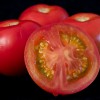 Several economic factors should be considered in selecting an agricultural irrigation system. This 7-page fact sheet compares two widely used irrigation systems for tomato production: seepage and sub-surface drip irrigation. Written by Jenna Rogers, Tatiana Borisova, Jeffrey Ullman, Kelly Morgan, Lincoln Zotarelli, and Kelly Grogan, and published by the UF Department of Food and Resource Economics, October 2014. (UF/IFAS Photo: Tyler Jones)
Several economic factors should be considered in selecting an agricultural irrigation system. This 7-page fact sheet compares two widely used irrigation systems for tomato production: seepage and sub-surface drip irrigation. Written by Jenna Rogers, Tatiana Borisova, Jeffrey Ullman, Kelly Morgan, Lincoln Zotarelli, and Kelly Grogan, and published by the UF Department of Food and Resource Economics, October 2014. (UF/IFAS Photo: Tyler Jones)
http://edis.ifas.ufl.edu/fe960
Florida Strawberry Producers' Experiences with Anthracose and Botrytis Fruit Rot, and Producers' Use of the Strawberry Advisory System
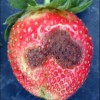 Florida’s producers use fungicides to manage anthracnose and botrytis fruit rot diseases, which find favorable growth conditions in Florida’s climate and can reduce strawberry yields and profits. The Strawberry Advisory System (SAS) uses information about weather conditions and user-entered information about past fungicide applications to evaluate the potential spread of these diseases in strawberry fields. If the risk of disease spread is low, no fungicide application is recommended, allowing producers to save on fungicide application costs. In this study, we summarize the results of a 2012/2013 survey of strawberry producers, and focus on the questions, How significant is the impact of anthracnose and botrytis on Florida strawberry producers’ yields? What are the typical fungicide application frequencies used by the producers? What percent of strawberry producers use SAS? and Are there any effects of SAS subscription on producers’ fungicide application? This 4-page fact sheet was written by Tatiana Borisova, Zhengfei Guan, Ekaterina Vorotnikova, Natalia Peres, and John VanSickle, and published by the UF Department of Food and Resource Economics, October 2014.
Florida’s producers use fungicides to manage anthracnose and botrytis fruit rot diseases, which find favorable growth conditions in Florida’s climate and can reduce strawberry yields and profits. The Strawberry Advisory System (SAS) uses information about weather conditions and user-entered information about past fungicide applications to evaluate the potential spread of these diseases in strawberry fields. If the risk of disease spread is low, no fungicide application is recommended, allowing producers to save on fungicide application costs. In this study, we summarize the results of a 2012/2013 survey of strawberry producers, and focus on the questions, How significant is the impact of anthracnose and botrytis on Florida strawberry producers’ yields? What are the typical fungicide application frequencies used by the producers? What percent of strawberry producers use SAS? and Are there any effects of SAS subscription on producers’ fungicide application? This 4-page fact sheet was written by Tatiana Borisova, Zhengfei Guan, Ekaterina Vorotnikova, Natalia Peres, and John VanSickle, and published by the UF Department of Food and Resource Economics, October 2014.
http://edis.ifas.ufl.edu/fe957
Establishment Cost of Avocados in South Florida
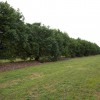 A major concern for the future of the Florida avocado industry is laurel wilt disease (LW), which is caused by fungus transmitted by the ambrosia beetle. Cost-effective management of LW relies heavily on the early detection and destruction of affected trees (sanitation). While not an official recommendation, some suggest that since the beetles are less attracted to younger trees, growers might consider leaving the young orchards in production while replanting only older and less productive orchards. Since the long-term survival of the Florida avocado industry may ultimately depend on a combination of eradication, prophylactic treatment, and replanting the trees, the purpose of this article is to provide an updated guidance on the costs of establishing an avocado orchard. Information presented in this study is based on interviews with growers, orchard service companies, extension agents, and other industry personnel. It is intended as a guide only to make production decisions, prepare budgets, and investigate insurance options. A follow-up document to this one will focus on the cost and return of maintaining an orchard after it has been established. This 9-page fact sheet was written by Braulia De Oleo, Edward A. Evans, and Jonathan H. Crane, and published by the UF Department of Food and Resource Economics, October 2014.
A major concern for the future of the Florida avocado industry is laurel wilt disease (LW), which is caused by fungus transmitted by the ambrosia beetle. Cost-effective management of LW relies heavily on the early detection and destruction of affected trees (sanitation). While not an official recommendation, some suggest that since the beetles are less attracted to younger trees, growers might consider leaving the young orchards in production while replanting only older and less productive orchards. Since the long-term survival of the Florida avocado industry may ultimately depend on a combination of eradication, prophylactic treatment, and replanting the trees, the purpose of this article is to provide an updated guidance on the costs of establishing an avocado orchard. Information presented in this study is based on interviews with growers, orchard service companies, extension agents, and other industry personnel. It is intended as a guide only to make production decisions, prepare budgets, and investigate insurance options. A follow-up document to this one will focus on the cost and return of maintaining an orchard after it has been established. This 9-page fact sheet was written by Braulia De Oleo, Edward A. Evans, and Jonathan H. Crane, and published by the UF Department of Food and Resource Economics, October 2014.
http://edis.ifas.ufl.edu/fe956
An Overview of US Blueberry Production, Trade, and Consumption, with Special Reference to Florida
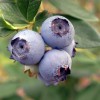 This 8-page fact sheet provides updated information about the recent trends in blueberry production, consumption, and trade for the US market. Current and future short-term trends are discussed. Price analysis at the wholesale level for selected markets on the US East Coast (New York City) and US West Coast (Los Angeles) are presented. Also, the national average retail prices for conventional and organic blueberries are presented. Written by Edward A. Evans and Fredy H. Ballen, and published by the UF Department of Food and Resource Economics, October 2014.
This 8-page fact sheet provides updated information about the recent trends in blueberry production, consumption, and trade for the US market. Current and future short-term trends are discussed. Price analysis at the wholesale level for selected markets on the US East Coast (New York City) and US West Coast (Los Angeles) are presented. Also, the national average retail prices for conventional and organic blueberries are presented. Written by Edward A. Evans and Fredy H. Ballen, and published by the UF Department of Food and Resource Economics, October 2014.
http://edis.ifas.ufl.edu/fe952
Tracking the Economic Benefits Generated by the Hard Clam Aquaculture Industry in Florida
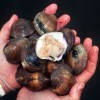 The hard clam industry is a true success story for commercial aquaculture in Florida. From a cottage industry borne of reductions in commercial wild clam harvests in the Indian River Lagoon during the late 1980s, hard clam aquaculture has now developed into an industry that is rivaled by no other aquaculture food product in Florida. Although successful by virtually any metric, the risks and uncertainty associated with commercial hard clam culture has led to the evaluation of programs that help mitigate risk, such as the former pilot Cultivated Clam Crop Insurance Program administered by USDA Risk Management Agency. All of this alludes to the economic importance of the hard clam culture industry which, through the cultivation process and sales of products, generates local income and taxes, creates jobs and businesses, and draws new money into the local economy, as cultured hard clams are sold to non-residents and buyers outside the region and state. This 6-page fact sheet provides an overview of a recent study by the University of Florida to provide an estimate of the impact of the hard clam industry to the Florida economy. Written by Charles Adams, Leslie Sturmer, and Alan Hodges, and published by the UF Department of Food and Resource Economics, October 2014. (UF/IFAS photo by Tom Wright)
The hard clam industry is a true success story for commercial aquaculture in Florida. From a cottage industry borne of reductions in commercial wild clam harvests in the Indian River Lagoon during the late 1980s, hard clam aquaculture has now developed into an industry that is rivaled by no other aquaculture food product in Florida. Although successful by virtually any metric, the risks and uncertainty associated with commercial hard clam culture has led to the evaluation of programs that help mitigate risk, such as the former pilot Cultivated Clam Crop Insurance Program administered by USDA Risk Management Agency. All of this alludes to the economic importance of the hard clam culture industry which, through the cultivation process and sales of products, generates local income and taxes, creates jobs and businesses, and draws new money into the local economy, as cultured hard clams are sold to non-residents and buyers outside the region and state. This 6-page fact sheet provides an overview of a recent study by the University of Florida to provide an estimate of the impact of the hard clam industry to the Florida economy. Written by Charles Adams, Leslie Sturmer, and Alan Hodges, and published by the UF Department of Food and Resource Economics, October 2014. (UF/IFAS photo by Tom Wright)
http://edis.ifas.ufl.edu/fe961
Citrus Mechanical Harvesting Systems–Continuous Canopy Shakers
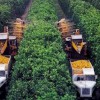 Mechanization has been the hallmark of American agriculture. Nearly 100 percent of the agronomic crops grown in the United States are plowed, planted, and harvested with mechanical equipment. Mechanical harvesting equipment for sweet oranges has been studied extensively since the 1970s and during the 2005/06 harvest season, trunk and canopy shakers harvested more than 36,000 acres of Florida citrus. Mechanically harvested citrus acreage, however, has decreased significantly since 2005. During the 2012/13 season, less than 9,000 acres were mechanically harvested (FDOC 2013). Nevertheless, development and adoption of mechanical harvesting technology is important to the long-term economic sustainability of the Florida orange juice processing industry. This 5-page fact sheet describing canopy shakerswas written by F.M. Roka, R.J. Ehsani, S.H. Futch, and B.R. Hyman, and published by the UF Department of Food and Resource Economics, August 2014.
Mechanization has been the hallmark of American agriculture. Nearly 100 percent of the agronomic crops grown in the United States are plowed, planted, and harvested with mechanical equipment. Mechanical harvesting equipment for sweet oranges has been studied extensively since the 1970s and during the 2005/06 harvest season, trunk and canopy shakers harvested more than 36,000 acres of Florida citrus. Mechanically harvested citrus acreage, however, has decreased significantly since 2005. During the 2012/13 season, less than 9,000 acres were mechanically harvested (FDOC 2013). Nevertheless, development and adoption of mechanical harvesting technology is important to the long-term economic sustainability of the Florida orange juice processing industry. This 5-page fact sheet describing canopy shakerswas written by F.M. Roka, R.J. Ehsani, S.H. Futch, and B.R. Hyman, and published by the UF Department of Food and Resource Economics, August 2014.
http://edis.ifas.ufl.edu/fe951
Citrus Mechanical Harvesting Systems–Trunk Shakers
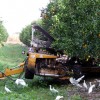 While citrus growers are rightfully concerned about restoring the health of their HLB-infected trees, more study and consideration should be given to mechanical harvesting. The costs to grow and harvest citrus have been escalating significantly since 2006, and the cost savings potential from mechanical harvesting technologies can help Florida growers remain economically viable. This 4-page fact sheet was written by F.M. Roka, R.J. Ehsani, S.H. Futch, and B.R. Hyman, and published by the UF Department of Food and Resource Economics, August 2014.
While citrus growers are rightfully concerned about restoring the health of their HLB-infected trees, more study and consideration should be given to mechanical harvesting. The costs to grow and harvest citrus have been escalating significantly since 2006, and the cost savings potential from mechanical harvesting technologies can help Florida growers remain economically viable. This 4-page fact sheet was written by F.M. Roka, R.J. Ehsani, S.H. Futch, and B.R. Hyman, and published by the UF Department of Food and Resource Economics, August 2014.
http://edis.ifas.ufl.edu/fe950
Eye-Tracking Methodology and Applications in Consumer Research
 Eye-tracking technology is a means of exploring the relationship between visual attention and consumer behavior. In the past, eye-tracking technology has been used to conduct research on consumer decision-making, marketing, and advertising. This 5-page fact sheet serves as an introduction to eye-tracking technology and methodology. Written by Hayk Khachatryan and Alicia L. Rihn, and published by the UF Department of Food and Resource Economics, July 2014.
Eye-tracking technology is a means of exploring the relationship between visual attention and consumer behavior. In the past, eye-tracking technology has been used to conduct research on consumer decision-making, marketing, and advertising. This 5-page fact sheet serves as an introduction to eye-tracking technology and methodology. Written by Hayk Khachatryan and Alicia L. Rihn, and published by the UF Department of Food and Resource Economics, July 2014.
http://edis.ifas.ufl.edu/fe947
Florida Nursery Crops and Landscaping Industry Economic Impacts, Situation, and Outlook
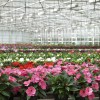 Florida is one of the leading environmental horticulture producers in the United States, ranked second only to California. In 2010, total industry sales were estimated at $12.33 billion. This 10-page report summarizes the current situation, economic impacts, and outlook for the environmental horticulture industry in Florida. Written by Hayk Khachatryan and Alan W. Hodges, and published by the UF Department of Food and Resource Economics, September 2014.
Florida is one of the leading environmental horticulture producers in the United States, ranked second only to California. In 2010, total industry sales were estimated at $12.33 billion. This 10-page report summarizes the current situation, economic impacts, and outlook for the environmental horticulture industry in Florida. Written by Hayk Khachatryan and Alan W. Hodges, and published by the UF Department of Food and Resource Economics, September 2014.
http://edis.ifas.ufl.edu/fe946
